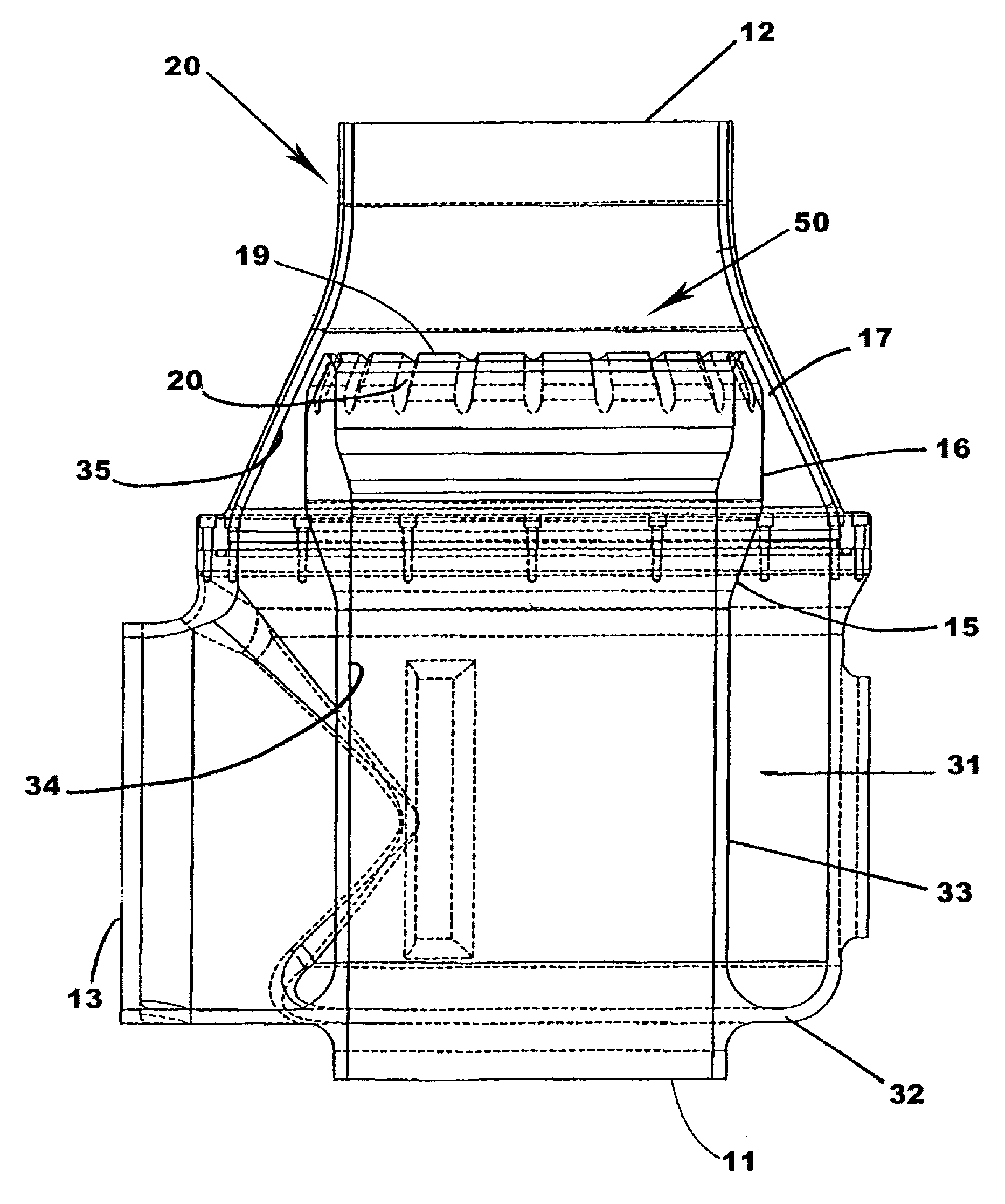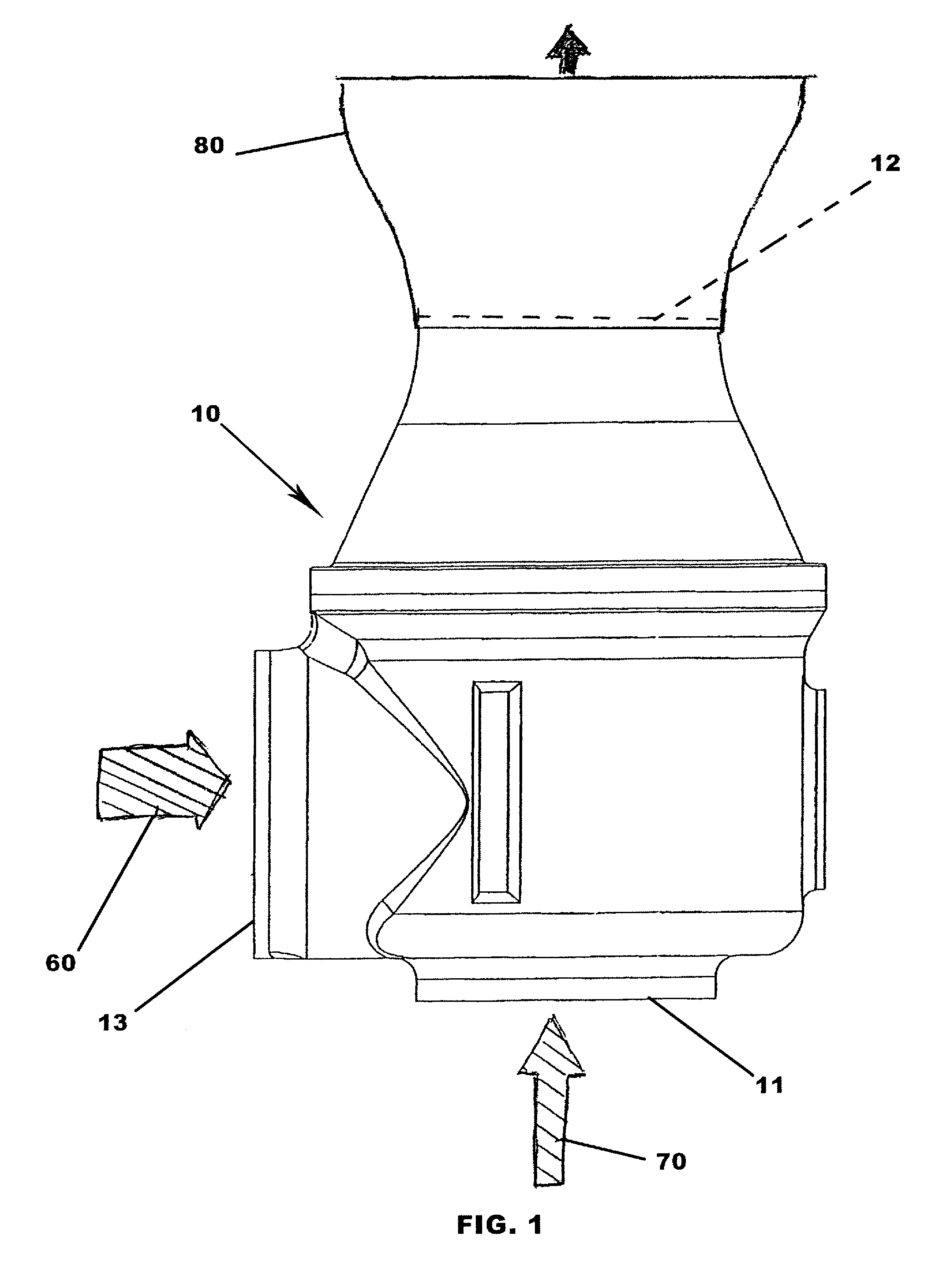Fish pump
a technology for fish and pump, applied in the field of fish pumps, can solve the problems of fish present a particular problem, severe damage to fish, injury or death of fish, etc., and achieve the effect of inhibiting damage to the product passing through the pump
- Summary
- Abstract
- Description
- Claims
- Application Information
AI Technical Summary
Benefits of technology
Problems solved by technology
Method used
Image
Examples
example 1
[0043]A pump of the prior art having a gap injection angle of 43 degrees and 0.4 inches has a flow ratio of 0.362. The addition of a discharge nozzle increase the flow ratio to 0.4.
[0044]If the gap injection angle of 43 degrees is maintained but the gap reduced to 0.3 inches, the efficiency allows a flow ratio of 0.508. The addition of the discharge orifice of this invention increases the flow ratio to 0.532. If the flutes are present on the orifice, but no discharge nozzle, the efficiency is raised from 0.508 to 0.528. If the discharge nozzle is included with the orifice flutes, then the efficiency is raised from 0.508 to 0.543.
[0045]If the gap injection angle of 43 degrees is maintained but the gap angle reduced to 0.2 inches, the efficiency allows a flow ratio of 0.560. The addition of a discharge orifice increases the flow ratio to 0.600. If the flutes are present on the orifice, but no discharge nozzle, the flow ratio is raised from 0.560 to 0.570. If the discharge nozzle is in...
example 2
[0046]A pump of the prior art having a gap injection angle of 35 degrees and 0.4 inches has a flow ratio of 0.440. The addition of a discharge orifice increases the flow ratio to 0.470.
[0047]If the gap injection angle of 35 degrees is maintained but the gap angle reduced to 0.2 inches, the efficiency allows a flow ratio of 0.592. The addition of a discharge orifice increases the flow ratio to 0.622. If the flutes are present on the orifice, but no discharge nozzle, the flow ratio is raised from 0.592 to 0.623. If the discharge nozzle is included with the orifice flutes, then the flow ratio is raised from 0.592 to 0.640.
example 3
[0048]A pump of the prior art having a gap injection angle of 25 degrees and 0.4 inches has a flow ratio of 0.457. The addition of a discharge orifice increases the flow ratio to 0.471.
[0049]If the gap injection angle of 25 degrees is maintained but the gap angle reduced to 0.2 inches, the efficiency allows a flow ratio of 0.651. The addition of a discharge nozzle increases the flow ratio to 0.674. If the flutes are present on the orifice, but no discharge nozzle, the flow ratio is raised from 0.651 to 0.707. If the discharge nozzle is included with the orifice flutes, then the flow ratio is raised from 0.651 to 0.739.
[0050]The test performed evidences that the prior art pump having a 43 degree angle and 0.4 inch gap can have the flow ratio increased from 0.362 to 0.739 by use of a 25 degree angle with a 0.2 inch gap wherein the orifice is fluted and a discharge nozzle is added to the pump. Coanda pumps with small gaps can be configured to have higher efficiencies than with large ga...
PUM
 Login to View More
Login to View More Abstract
Description
Claims
Application Information
 Login to View More
Login to View More - R&D
- Intellectual Property
- Life Sciences
- Materials
- Tech Scout
- Unparalleled Data Quality
- Higher Quality Content
- 60% Fewer Hallucinations
Browse by: Latest US Patents, China's latest patents, Technical Efficacy Thesaurus, Application Domain, Technology Topic, Popular Technical Reports.
© 2025 PatSnap. All rights reserved.Legal|Privacy policy|Modern Slavery Act Transparency Statement|Sitemap|About US| Contact US: help@patsnap.com



